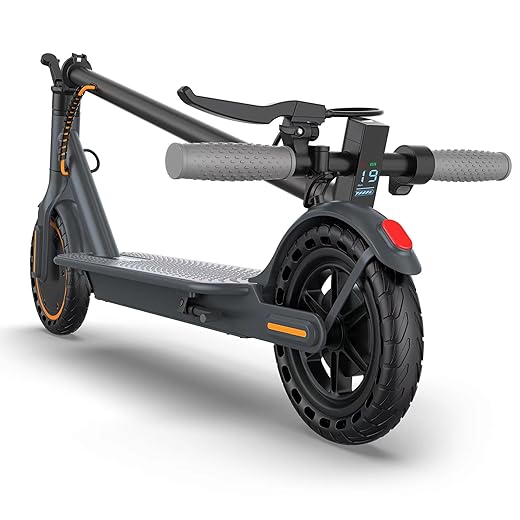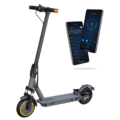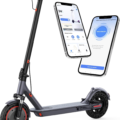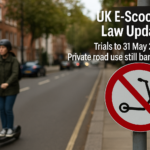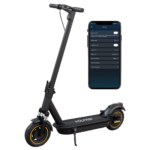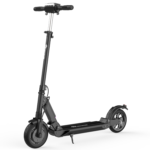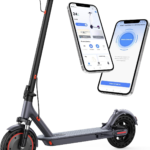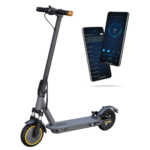- Home
- Scooters
- Electric Scooters
- VOLPAM SP03
VOLPAM SP03
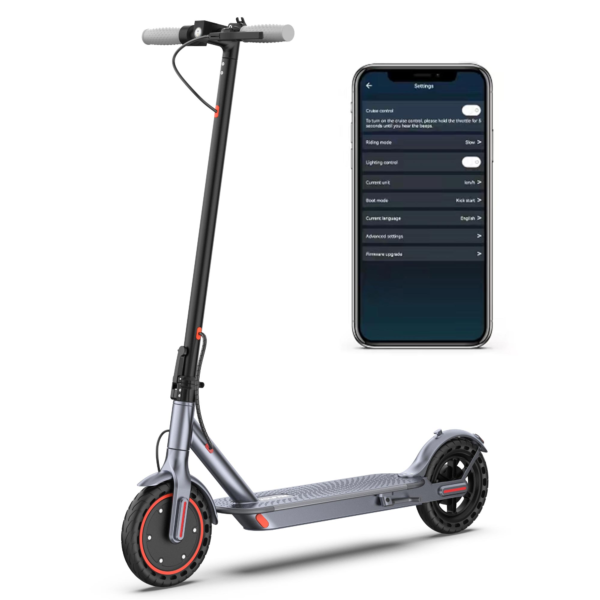

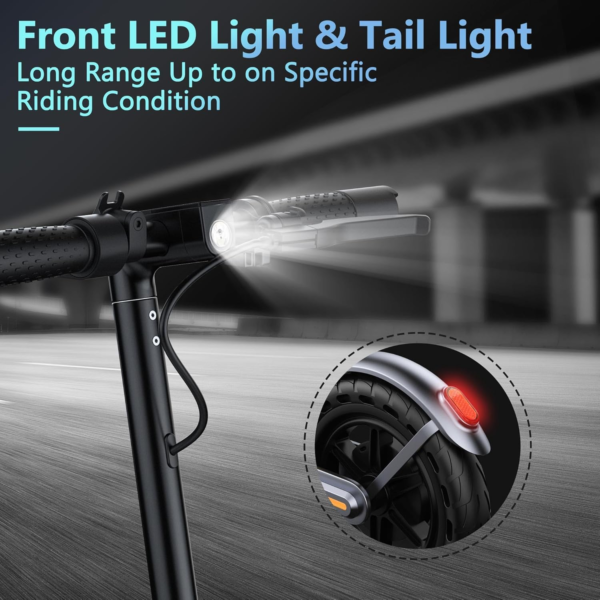
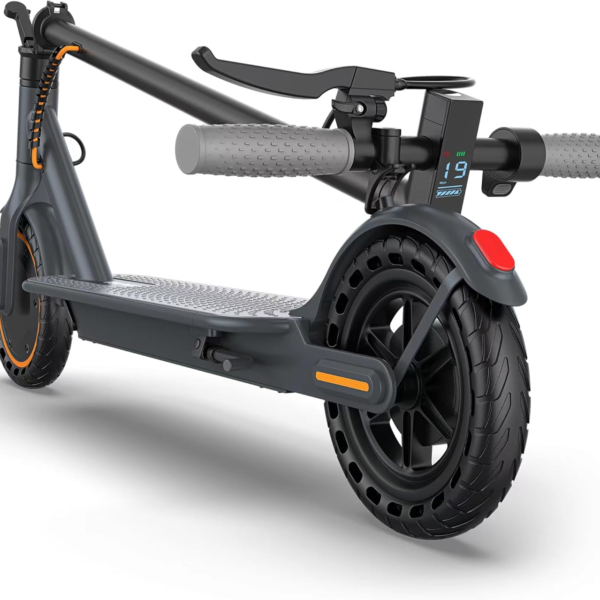
- Battery Range: 20 miles (32 km)
- Top Speed: 15.5 mph (25 km/h)
- Motor Power: 350 W
- Weight Capacity: 264 lb (120 kg)
- Charging Time: Approx. 4–5 hours
- Scooter Weight: 26.5 lb (12.0 kg)
PROS
- 350W hub motor for city speeds
- Up to ~20 miles range
- Dual braking: front electronic + rear disc
- 8.5″ maintenance-free solid tires
- Tuya Smart app with cruise mode
CONS
- No published suspension
- IP rating not specified
- Modest top speed (15.5 mph)
- Folded/unfolded dimensions not specified
Table of contents
- What Is the VOLPAM SP03?
- How the VOLPAM SP03 Works
- Key Specifications
- Design & Build Quality
- Performance Fundamentals
- Battery, Range & Efficiency
- Ride Quality & Comfort
- Braking & Safety Features
- Portability & Daily Usability
- Maintenance & Care
- Weather & Seasonal Considerations
- VOLPAM SP03 vs Alternatives
- Who the VOLPAM SP03 Is (and Isn’t) For
- FAQs
- Glossary
- Final Thoughts
Key Takeaways
- The VOLPAM SP03 features a 350W hub motor, a 36V battery, and a top speed of 19 mph, making it ideal for short city commutes.
- This scooter prioritizes user-friendliness with solid honeycomb tires, quick folding, and easy storage, making it perfect for students and new riders.
- Its battery offers a maximum range of 19 miles, but actual distances may vary based on rider weight and terrain.
- The SP03 emphasizes low maintenance, with features that allow for easy care and no risk of flat tires.
- Overall, the VOLPAM SP03 suits those seeking low upkeep and reliable performance for daily urban travel.
Looking for a scooter you can grab and go? The VOLPAM SP03 keeps things simple. It runs a 350W hub motor, a 36V battery, and rolls at up to 19 mph (30 km/h). Range lands near 19 miles (30 km) in easy conditions. So it fits students, new riders, and anyone who wants a light, calm ride to work or class. If you want something even simpler for short hops, see the VOLPAM Q1.
It leans more on day-to-day use than flash. You get 8.5-inch solid tires, a rear disc with electronic assist, a small LCD, and quick folding. Then you pick it up, hop on a bus, and stash it under a desk. Easy.
What Is the VOLPAM SP03?
The VOLPAM SP03 is a compact city scooter aimed at short trips and light commutes. It keeps parts simple. The motor sits in the wheel hub. The battery lives low in the deck. Solid honeycomb tires skip punctures. Meanwhile, the cockpit stays tidy, so the screen and buttons are not a puzzle.
Daily use feels straightforward. You fold it in seconds, carry it up a flight, then park it under a table. Speed tops out around 19 mph (30 km/h), which matches most city paths. Range taps out near 19 miles (30 km) if you ride easy on flat ground. Heavier riders and hills cut that number, which is normal.
How the VOLPAM SP03 Works
Think of the battery as a small fuel tank. The controller is the faucet. The motor is the water wheel. You press the throttle, the faucet opens, and the wheel spins. You pull the brake, a caliper squeezes the rear rotor, and the controller adds electronic braking to slow the hub.
This layout keeps moving parts low. There is no chain to grease and no belt to align. The deck holds the battery low for stability. Then the stem locks with a folding latch, so you can collapse the scooter fast. After that, just carry, unfold, and roll.
Key Specifications
Here is a clean, grouped view of the core specifications. When a value is not published by the maker, it is marked as such.
| Section | Details |
|---|---|
| General | Brand: VOLPAM • Model: SP03 • Color: Grey • Max rider: 264 lb (120 kg) • Use: Urban/commuter |
| Performance & Power | Motor: 350W brushless rear hub • Top speed: up to 19 mph (30 km/h) • Drive: Rear hub • Hill grade: Not stated |
| Battery, Charging & Electrical | Battery: 36V, 280.8 Wh (≈ 7.8 Ah) • Rated range: up to 19 miles (30 km) • Charge time: about 4–5 hours • Display: LCD • App: Bluetooth basics |
| Build & Dimensions | Frame: Aluminum alloy • Tires: 8.5 in solid honeycomb • Suspension: Not listed • Unfolded size: Not stated • Folded size: Not stated • Net weight: Not stated |
| Safety & Control | Brakes: Rear disc + electronic assist • Lights: Front LED and rear light • Reflectors: Yes • Water resistance/IP: Not stated |
| Features & Extras | Fast fold latch • Kickstand • LCD readout • App for simple settings |
| Warranty & Compliance | Warranty: 12 months or 180 days, part-dependent • Electrical listing: Not stated |
Overall, these specifications favor low upkeep and steady city pace.
Design & Build Quality
The frame is aluminum, so it feels light but not flimsy. The hinge clicks shut with a firm snap. Cables sit close to the stem, and the deck has grip that actually grips. Fit lines are clean for this class. On smooth streets, it rides quiet and avoids rattles.
The cockpit is friendly. The throttle sits under your right thumb. The left lever controls the rear disc. The screen shows speed and battery bars without glare at night. So you can glance down, get what you need, and look back up quick.
Deck space is decent for a staggered stance. You can square your feet at low speed, then switch to a wider stance as pace picks up. Fenders keep most spray off your shoes. Nothing feels precious if you fold with care and avoid yanking on the stem.
Performance Fundamentals
From a stop, power comes in smooth. A small kick helps the controller engage. Then the 350W hub pulls you toward a calm cruise around 15 to 19 mph (25 to 30 km/h). Launch is not wild, which is nice for new riders. Near top speed, power tapers, so the scooter stays settled.
On flat ground, the rear drive helps traction as you roll on the throttle. The battery sits low in the deck, which keeps the center of gravity down. So the steering stays light and the scooter tracks straight with small inputs.
On short hills around 7 to 10 percent, expect speed to dip. If you are close to the 264 lb (120 kg) limit, you will feel it more. A short run-up helps. Then the motor holds a steady pull if the grade is not long.
Battery, Range & Efficiency
Capacity is 280.8 Wh at 36V, which comes out to about 7.8 Ah. That pairing fits a 350W hub and city speeds. The brand rates up to 19 miles (30 km) on a full charge. Real rides vary with rider mass, wind, grade, stops, and cold pavement. So plan a buffer if your route is hilly or winter is in full swing.
A few quick examples help. A 150 lb (68 kg) rider on flat streets at 12 to 14 mph (20 to 23 km/h) should cover 7 to 10 miles (11 to 16 km) and still have some left. A 220 lb (100 kg) rider on rolling roads at 15 to 17 mph (24 to 27 km/h) may want a top-up for a long round trip. Cold mornings cut range. Warm tarmac helps a bit.
Charging from low takes roughly 4 to 5 hours. So overnight works, and a workday charge works too. For pack health, avoid storing it empty. Unplug soon after it reaches full. If you will not ride for a while, park it near half and keep it in a cool room. Then check it monthly and add a short charge if needed.
Ride Quality & Comfort
Solid honeycomb tires take flats off your list. The ride feels firmer than air-filled tires, which is the trade. Grip tape on the deck keeps your stance planted over small cracks. The steering column holds line well at city pace and still turns easily at walking speed.
On cracked asphalt, bend your knees and let your ankles move. That simple stance soaks up buzz and keeps your hands relaxed. The scooter feels best on smooth lanes and paved paths. It can manage seams and small pavers. Even so, slow down for potholes and rough patches.
Controls feel light. The brake lever does not need much force. The throttle throw is short, which helps in tight places. You can creep through a parking lot, steer around people with care, and stop right where you planned. That takes stress out of short daily rides.
Braking & Safety Features
The rear disc gives a clear bite. Pads start to do real work about halfway through the pull. Electronic braking adds drag at the hub and trims stopping distance at city speed. So straight stops feel controlled if you shift weight back and brace your core.
Lighting covers front and rear. The headlight marks your lane. The rear light helps at dusk. For darker routes, add a helmet light and wear something bright. Reflectors on the sides boost side-on visibility near traffic.
There is no published IP rating. So avoid heavy rain and deep puddles. If the scooter gets wet, dry it with a towel and park it indoors. Let it warm to room temperature before you charge.
Portability & Daily Usability
Folding is quick. Pull the latch, drop the stem, hook it to the rear fender, and lift. The balance point sits near the latch, which helps one-hand carries for short walks. For longer carries, use two hands and keep the stem upright to save your wrist.
Storage is simple. Slide it under a desk or stand it behind a door. On trains, face it away from seats and keep a hand on the stem. Little habits like that stop scuffs and keep people happy.
For short stops, bring it inside when you can. If you must lock it, use a tough lock around a fixed post and keep the lock off the ground. Remove small add-ons and power it off.
Maintenance & Care
A small routine goes a long way.
- Before each ride: Squeeze the brake and feel for solid bite. Spin the wheels and check for debris in the tire holes. Then make sure the latch is fully closed.
- Weekly: Wipe down the frame and deck. Check caliper and rotor screws for snug fit. Look for cable rub near the hinge.
- Monthly: Watch for rotor rub and adjust the caliper if needed. Scan the rear tire for cuts or chips. Verify rear axle nuts are tight.
- Every 3 months: Check the hinge hardware for play. Tighten to spec if it loosened. Afterward, clean the rotor with isopropyl alcohol.
- Battery care: Store at 50–77 °F (10–25 °C). If you will pause riding, park at about half charge and check once a month.
Solid tires mean no patch kits and no pump. Keep a small hex set, a Torx for the rotor, a rag, and some alcohol. With that, most small jobs are covered.
Weather & Seasonal Considerations
Cold air pulls range down. Hot days stress parts. So adjust speed and distance with the season. In winter, give yourself more braking space. Paint lines and metal plates get slick. In summer, park in the shade and let the scooter cool a bit before you charge.
Rain raises risk, especially without a published IP rating. So avoid downpours and puddles. If the ground is damp, coast through corners instead of powering out of them. On gritty lanes, stand tall and keep the bars steady. That way, the front tire tracks straight through loose bits.
Windy day? Hold the bars with both hands. Lean your body into gusts instead of steering into them. A staggered stance helps. Next, pick streets with wind breaks if you have that option.
VOLPAM SP03 vs Alternatives
Against other entry commuters, the SP03 leans on easy care. Solid tires stop flats, and the dual-brake setup adds confidence at city speed. Many rivals match the headline speed and the claimed range. Even so, few in this tier keep maintenance this light while staying calm around 15 to 19 mph. If you want a close sibling with a slightly different tune, the VOLPAM SP01 is worth a look.
Against bigger performance scooters, the SP03 trades punch for size and weight. You win on carry comfort, quick folding, and under-desk storage. You lose strong hill pull and suspension travel. For flat or rolling towns, that trade makes sense.
Light off-road paths are not its thing. The tires and clearances suit pavement, brick, and hard-packed park lanes. Save rough gravel and roots for a different class.
Who the VOLPAM SP03 Is (and Isn’t) For
Great fits
- Short city commutes under 6–8 miles (10–13 km) each way
- Students who need small storage and quick folding
- Multi-modal trips with trains or buses
- New riders who want smooth power and friendly brakes
- Anyone who wants low upkeep and no flats
Poor fits
- Long, steep hills on a daily route
- Heavy cargo or frequent two-up use
- Broken pavement and potholes all the time
- High-speed suburban runs day after day
Bottom line, match the scooter to your route. If your path is short and smooth, the SP03 makes sense. If your route is steep or rough, look at a larger model with air tires and more motor headroom.
FAQs
Does the SP03 have enough power for daily city rides?
Yes, on flat ground and mild grades. Expect 12 to 18 mph (19 to 29 km/h) in normal traffic. On long hills, plan a lower cruise.
How far can I ride on one charge?
The rated max is up to 19 miles (30 km). Real range changes with rider weight, speed, stops, wind, hills, and cold temps.
Can I ride in the rain?
There is no published IP rating. So avoid heavy rain and standing water. If it gets wet, dry it and let it warm to room temp before charging.
What tires does it use?
8.5-inch solid honeycomb tires. They skip punctures and cut upkeep. The ride is firmer than air tires, so slow down on rough sections.
How do the brakes feel?
Lever feel is light. Bite builds about halfway through the pull. Electronic braking helps finish the stop and keeps things straight.
Is the fold fast enough for buses or trains?
Yes. The latch drops the stem in seconds. Hook it, lift from the balance point, then set it down and unfold at your stop.
Where can I find a quick VOLPAM SP03 overview?
Right here. The sections above cover design, performance, comfort, safety, and care.
Glossary
Ah (amp-hours): Battery charge capacity.
Wh (watt-hours): Energy capacity, roughly voltage times amp-hours.
Controller: The part that meters battery power to the motor.
Brushless motor: Quiet motor with electronic commutation.
Hub motor: Motor built into the wheel that drives the wheel directly.
Regen (electronic braking): Motor resistance that helps slow the scooter.
Caliper: Piece that squeezes pads onto the rotor.
Rotor: Metal disc the caliper grabs.
Stem: Folding column that holds the handlebar.
Stem flex: Small side movement under load.
Deck: Platform for your feet.
IP rating: Code for dust and water resistance.
Solid tire: Tire with no tube, no flats, firmer ride.
Pneumatic tire: Air-filled tire with softer ride.
BMS: Battery management system for charging and discharge safety.
Final Thoughts
The VOLPAM SP03 keeps your routine light. It folds fast, rolls steady at city speeds, and asks for little care. Solid tires sidestep flats. Brakes feel friendly. Portability is the real win.
Pick it for short, smooth trips and it will fit right in. Keep a simple care plan, charge with a plan, and you are set for daily rides.
Specifications
General
| Model The Model specifies the exact version or name of the scooter. It helps identify its unique design, features, and specifications within the manufacturer’s product line. Knowing the model makes it easier to compare options, find compatible accessories, or look up support information. | SP03 |
| Brand The Brand identifies the manufacturer or company that designs and produces the scooter. A trusted brand is a sign of quality, reliability, and good customer support. Well-known brands often have higher standards for safety, performance, and after-sales service, giving you more confidence in your purchase. | VOLPAM |
| Release Date The Release Date indicates when the scooter model was officially launched on the market. This helps you know how current the design, technology, and features are. A newer release date often means updated components, improved performance, and the latest safety or smart features. | 18 November 2025 |
| Recommended Age Recommended Age indicates the minimum age range that the scooter is designed for, based on safety, size, and ease of use. Following the recommended age helps ensure that riders can handle the scooter’s speed, weight, and controls comfortably and safely. Always check local laws and use protective gear, especially for younger riders. | +16 |
Performance & Power
| Motor Power (Wattage) What it means: The motor power, measured in watts (W), shows how strong the scooter’s electric motor is. Why it matters: Higher wattage usually means better acceleration, more torque, and improved performance on hills or rough terrain. For example, a 250W motor is good for flat city roads and light riders, while a 500W or 1000W motor provides more power for faster speeds or climbing steep inclines. | 350 W brushless hub motor |
| Top Speed The Top Speed indicates the maximum speed that the scooter can reach under optimal conditions. It’s usually measured on level ground with a fully charged battery and an average rider weight. A higher top speed allows you to travel longer distances faster, but always ensure you ride within legal speed limits and your personal comfort zone for safety. | 15.5 mph (25 km/h) |
| Battery Capacity Battery Capacity refers to the total amount of energy the scooter’s battery can store, usually measured in ampere-hours (Ah) or watt-hours (Wh). A higher battery capacity means you can ride longer distances on a single charge, reducing the need for frequent recharging. Keep in mind that actual range can vary depending on rider weight, terrain, speed, and weather conditions. | 36 V (Ah/Wh Not specified) |
| Estimated Range per Charge The Estimated Range per Charge indicates the average distance the scooter can travel on a single full battery charge. This range is calculated under optimal conditions, such as flat terrain, moderate speed, and average rider weight. Real-world range may vary depending on riding style, terrain, weather, and load. A longer range means fewer recharges and greater freedom for longer trips. | 20 miles (32 km) |
| Hill Climb Ability Hill Climb Ability describes the maximum incline or slope that the scooter can handle while maintaining stable performance. It’s typically expressed as a percentage or in degrees. A higher hill climb rating means the scooter can tackle steeper hills without losing too much speed or power. Actual climbing performance may vary based on rider weight, battery charge, and terrain conditions. | Max 20° |
Charging & Electrical
| Charging Time Charging Time indicates how long it takes to fully recharge the scooter’s battery from empty to 100% using the standard charger provided. Faster charging means less downtime and more time on the road. Actual charging time may vary slightly depending on battery capacity, charger output, and environmental conditions. | Approx. 4–5 hours |
| Battery Type Battery Type refers to the specific technology used in the scooter’s battery, which affects performance, lifespan, weight, and charging time. Most modern electric scooters use high-quality lithium-ion (Li-ion) batteries because they offer a good balance of energy density, durability, and low maintenance. A reliable battery type ensures consistent power delivery and longer riding ranges. | Lithium-ion |
| Removable Battery A Removable Battery means the battery pack can be easily detached from the scooter for convenient charging and replacement. This feature allows you to charge the battery separately, swap it with a spare for extended range, or securely store it indoors in extreme weather. Removable batteries add flexibility and make it easier to keep your scooter powered up wherever you are. | Non-removable internal battery |
| Regenerative Braking Regenerative Braking is an energy-saving feature that converts some of the energy normally lost during braking back into battery power. When you slow down or brake, the motor works in reverse to generate electricity, which helps extend the scooter’s range and improves overall efficiency. This system also reduces wear on traditional brake components, leading to lower maintenance over time. | Yes (electronic brake regen) |
| Lighting Lighting refers to the built-in front and rear lights that enhance visibility and safety when riding in low-light conditions or at night. Good lighting helps you see the road ahead and ensures that other road users can see you. Many scooters include LED headlights, taillights, and sometimes brake lights or side reflectors for added safety and compliance with local traffic regulations. | LED headlight + rear light |
Build & Dimensions
| Scooter Weight Scooter Weight refers to the total weight of the scooter when fully assembled, including the battery. This affects how easy it is to carry, lift, and store the scooter when not in use. A lighter scooter is more portable and convenient for commuting, especially if you need to carry it upstairs or onto public transport. Keep in mind that a sturdy frame and quality components may add to the weight but also contribute to better durability and ride stability. | 26.5 lb (12.0 kg) |
| Maximum Rider Weight Maximum Rider Weight indicates the highest rider weight that the scooter is designed to safely support while maintaining optimal performance and stability. Staying within this limit helps ensure reliable acceleration, braking, and climbing ability, and it protects the frame, suspension, and motor from excessive strain. Exceeding the recommended limit may reduce performance and increase wear on components. | 264 lb (120 kg) |
| Deck Size Deck Size refers to the dimensions of the scooter’s standing platform. A wider and longer deck provides more foot space, allowing you to stand comfortably and adjust your stance while riding. A well-sized deck improves balance and stability, especially on longer rides or at higher speeds. Compact decks, on the other hand, help keep the scooter lightweight and portable. | Standard commuter geometry |
| Handlebar Height Handlebar Height refers to the distance from the deck to the handlebars, which affects your riding posture and comfort. An appropriate handlebar height helps you maintain good balance, reduces strain on your back and arms, and makes steering more comfortable. Some scooters have adjustable handlebars to fit riders of different heights, while others have a fixed height for a streamlined design. | Not specified |
| Folding Mechanism The Folding Mechanism describes how easily and securely the scooter can be folded for carrying and storage. A well-designed folding system lets you quickly collapse the scooter into a compact size, making it convenient to transport on public transit, store under a desk, or fit into a car trunk. Look for sturdy latches and safety locks to ensure the scooter stays firmly in place when folded or unfolded. | Quick-folding stem latch |
| Dimensions Folded Dimensions indicate the size of the scooter when it’s fully folded. This measurement shows how much space the scooter will take up when stored or carried, making it easier to check if it will fit in your car trunk, under a desk, or in a closet. Compact folded dimensions are ideal for commuters who need to bring their scooter on public transport or store it in tight spaces. | Not specified |
| Material Material refers to the primary construction materials used for the scooter’s frame and key components. High-quality materials like aircraft-grade aluminum, reinforced steel, or durable composites provide strength, stability, and a lighter overall weight. A sturdy material ensures the scooter can handle daily wear and tear while maintaining safety and performance. | Not specified |
Safety & Control
| Brake Type(s) Brake Type(s) describe the braking systems the scooter uses to help you slow down or stop safely. Common brake types include mechanical brakes (like drum or disc brakes), electronic brakes, and foot brakes. Many scooters combine multiple braking systems for added safety and shorter stopping distances. The type and quality of brakes affect your control, especially when riding at higher speeds or on slopes. | Front electronic + rear disc |
| Suspension Suspension refers to the system that absorbs shocks and vibrations while riding, providing a smoother and more comfortable ride over uneven or rough surfaces. Scooters may have front suspension, rear suspension, or dual suspension for better shock absorption and stability. Good suspension helps reduce rider fatigue and improves control, especially when riding on bumpy roads or off-road paths. | None (not specified) |
| Tire Type Tire Type refers to the kind of tires the scooter uses, which directly affects ride comfort, traction, and maintenance. Common types include solid (airless) tires, pneumatic (air-filled) tires, or hybrid options. Pneumatic tires offer better shock absorption and a smoother ride on rough surfaces, while solid tires are puncture-proof and require less upkeep. The right tire type helps ensure safe handling and a comfortable ride in different conditions. | 8.5″ solid (anti-skid) |
| Tire Size Tire Size indicates the diameter and width of the scooter’s tires, which affect ride comfort, stability, and how well the scooter handles different terrains. Larger tires generally offer better shock absorption and a smoother ride over bumps and rough surfaces, while smaller tires keep the scooter lighter and more portable. Choosing the right tire size helps ensure a balance between agility and comfort. | 8.5-inch |
| Kickstand The Kickstand is a built-in stand that allows you to park your scooter upright when it’s not in use. A sturdy kickstand keeps the scooter stable and prevents it from tipping over, protecting it from scratches and damage. It also makes storing and accessing your scooter more convenient, whether you’re at home, work, or on the go. | Not specified |
| Water Resistance Rating Water Resistance Rating indicates how well the scooter is protected against water and moisture, usually shown as an IP (Ingress Protection) rating. This rating helps you understand whether the scooter can handle light rain, splashes, or wet roads without damage. While most scooters are not fully waterproof, a good water resistance rating adds peace of mind when riding in changing weather conditions. Always avoid deep puddles or submerging the scooter to protect its electrical components. | Not specified |
Features & Extras
| Display/Console The Display (or Console) shows important real-time information about your ride, helping you monitor your scooter’s status at a glance. Typical displays show speed, battery level, distance traveled, and riding mode. Some models also include additional features like Bluetooth connectivity, app integration, or backlighting for better visibility at night. A clear and easy-to-read display enhances safety and convenience on every trip. | LED display |
| Ride Modes Ride Modes refer to the different speed and power settings you can choose to match your riding style or road conditions. Common modes include eco for maximum range and energy efficiency, standard for everyday balance, and sport or turbo for higher speed and stronger acceleration. Switching between ride modes allows you to customize performance, conserve battery, and ride safely in various environments. | Riding + cruise modes |
| Smart App Connectivity Smart App Connectivity lets you pair your scooter with a dedicated mobile app via Bluetooth. Using the app, you can monitor real-time ride stats like speed, battery level, and range, adjust settings such as ride modes or cruise control, lock the scooter for added security, and sometimes receive firmware updates. This feature adds convenience and allows you to personalize your riding experience right from your smartphone. | Tuya Smart app (ride data, settings) |
| Anti-Theft System The Anti-Theft System helps protect your scooter from unauthorized use or theft. This feature can include built-in alarms, electronic motor locks, GPS tracking, or remote locking through a mobile app. A good anti-theft system provides peace of mind when parking your scooter in public spaces, adding an extra layer of security to safeguard your investment. | App lock (basic) |
| Cruise Control Cruise Control allows you to maintain a steady speed without continuously holding the throttle. This feature makes longer rides more comfortable by reducing hand fatigue and providing a smoother, more relaxed riding experience — especially on flat, open roads or bike lanes. For safety, cruise control can usually be easily activated or deactivated while riding. | Yes (hold throttle ~10 s) |
| Accessories Included Accessories Included lists the additional items that come with the scooter to enhance your riding experience and convenience. Common accessories may include a charger, kickstand, bell, lights, phone holder, or carrying strap. These extras add value by making your scooter safer, easier to use, and ready to ride straight out of the box. | Scooter, charger, user manual (typical) |
Warranty & Compliance
| Warranty Period The Warranty Period indicates how long the manufacturer guarantees the scooter against defects in materials and workmanship under normal use. A good warranty provides peace of mind, showing the brand’s confidence in its product quality. Always check what parts are covered, such as the frame, battery, and motor, and follow the maintenance guidelines to keep your warranty valid. | 12 months (region-dependent) |
| Certifications Certifications confirm that the scooter meets specific safety, quality, and environmental standards set by recognized organizations or regulatory bodies. Common certifications may include CE, RoHS, UL, or other local compliance marks, depending on your region. These certifications ensure that the scooter is manufactured to high standards and is safe and legal to use in your country. | Region-dependent |



